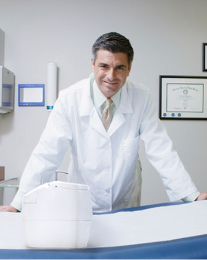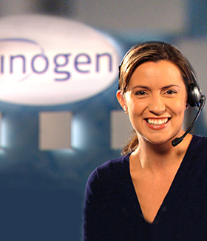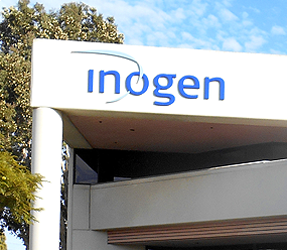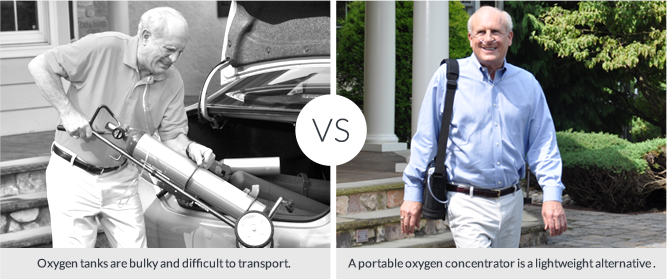What Is the difference between an Oxygen Tank and an Oxygen Concentrator?
When you are in search of a small oxygen tank for breathing, you might find yourself wondering about the differences between an oxygen concentrator vs. oxygen tank and how might you use them differently? Read on to learn how an oxygen concentrator and oxygen tank work when it comes to supplemental oxygen therapy treatments.
Oxygen Tank vs. Concentrator
You might be aware that both devices can deliver medical oxygen to those that require it. However, the methods of delivery for a stationary or portable oxygen concentrator vs. oxygen tank, as well as the device specifications, tend to differ quite a bit beyond that. Whether you are looking at a stationary oxygen tank vs. concentrator, or whether you are interested in lightweight portable oxygen tanks or portable oxygen concentrators, it is helpful to know the differences between the two delivery systems so you can make an educated decision with your doctor. Your oxygen therapy delivery device should provide you with the supplemental oxygen you need, but it should also allow you to maintain the best quality of life possible.
The main difference between an oxygen concentrator vs. oxygen tank is in how oxygen is provided to you. Whether it is a larger compressed oxygen tank or a smaller portable oxygen tank with liquid oxygen, oxygen tanks have a finite amount of oxygen within them, which is inhaled by the user until it runs out. Oxygen concentrators, on the other hand, filter and concentrate the surrounding air, generating medical-grade oxygen. Unlike an oxygen tank, an oxygen concentrator can provide an unlimited supply of oxygen so long as there is access to power or the battery that powers the machine remains charged.[1] However, other details can make a significant difference when you are trying to decide whether you would prefer an oxygen concentrator vs. tank.
Let’s take a closer look at how oxygen tanks and oxygen concentrators differ and explore the pros and cons of each oxygen delivery device. Whether you just need a stationary oxygen delivery device to use in your home, or you need a supplemental oxygen option that allows you to go out and about, weighing the pros and cons of each option can help.
Oxygen Tank or Cylinder
Oxygen tanks can hold either compressed oxygen or liquid oxygen. They are available in large tanks, generally for home use, or small portable oxygen tanks for breathing when you are out and about or traveling. Regardless of whether they are stationary or portable, oxygen tanks for breathing hold a specific amount of oxygen, and that means all of the oxygen a tank will ever have until it is refilled is already compressed within it. The oxygen supply within a tank is gradually reduced with use until the tank runs out and needs to be refilled or replaced. In order to easily travel and move about with an oxygen tank, many people prefer to fill a small portable oxygen tank to take with them when they are out. However, a small oxygen tank for breathing only holds a small amount of oxygen, which can be problematic, particularly if the unexpected arises. Moreover, you are prohibited from using even small portable oxygen tanks aboard airplanes, which could limit your ability to travel.
Liquid oxygen is a good option for people who need high liter flows of oxygen, usually greater than 6 liters per minute. This type of oxygen therapy uses pure oxygen which is compressed and frozen and then placed into metal cylinders. Liquid oxygen is very cold and can cause frostbite or burns if it comes in direct contact with your skin. [4]
Worrying about running out of oxygen, along with managing the replacement or refilling of tanks, can become a source of anxiety for patients getting their oxygen via oxygen tank vs. concentrator. If you or a loved one needs oxygen therapy, it is important to consider whether you feel comfortable managing oxygen tank refills and filling a small portable O2 tank anytime it is necessary to travel with oxygen. While the upfront cost of purchasing oxygen tanks is lower initially, one must also factor in the cost of refilling and replacing both home and portable oxygen tanks as the oxygen inside is used up, as these costs add up over time. [1]
Oxygen Tank Pros and Cons[1]
| Pros | Cons |
| Oxygen tanks are available in different sizes to make transporting them easier. | Oxygen tanks hold a finite amount of oxygen, meaning you run the risk of running out of oxygen altogether. |
| Oxygen tanks do not require power. | Tanks must be refilled or replaced when the oxygen inside is used up. |
| Purchasing oxygen tanks is less expensive up front. | Oxygen tanks are awkward, heavy and difficult to carry and travel with. |
| A conserver device, may be used to deliver oxygen in “pulses,” or bursts, when you inhale. | Oxygen tanks may be more expensive over time with ongoing costs of tank refills and replacements. |
| Oxygen tanks are prohibited aboard and for use on airplanes. | |
| Liquid oxygen requires special handling to prevent frostbite or burns. | |
| Oxygen tanks deliver continuous flow oxygen, so oxygen is dispensed even when you exhale. |
Oxygen Concentrator
An oxygen concentrator does not need to store oxygen, but instead uses the surrounding atmosphere to provide supplemental oxygen. So what is an oxygen concentrator? An oxygen concentrator takes air in from the surrounding atmosphere, compress and purify the air, removing nitrogen or other agents that complicate breathing. The newly purified and concentrated oxygen is then delivered to the patient via a nasal cannula in the desired flow setting to improve the user’s breathing.
When looking at an oxygen concentrator vs. tank, oxygen concentrators provide an obvious advantage because they do not need to be refilled. As long as the user has a charged battery or access to a power source, they will have an unlimited supply of oxygen available to them. Moreover, portable oxygen concentrators, which are compact and lightweight allow patients to go about their daily activities while getting the oxygen therapy they need. The cost of an oxygen concentrator is higher upfront, but long term, with responsible care and standard use, you will only need to purchase the occasional replacement part every few years. Also rental of portable oxygen concentrators may be an option.
Oxygen Concentrator Pros and Cons[1]
| Pros | Cons |
| An oxygen concentrator can provide an unlimited supply of oxygen as long as it has power. | An oxygen concentrator requires power via a charged battery or access to a power outlet to function. |
| An oxygen concentrator uses the surrounding air to produce supplemental oxygen, so it never needs to be refilled. | An oxygen concentrator does make a quiet sound when in use. |
| Oxygen concentrators are compact and portable, especially when using a portable oxygen concentrator model, which often weigh less than 5 pounds. | Oxygen concentrators cost more upfront. |
| Once purchased, the only additional costs are the occasional replacement part for your oxygen concentrator. | |
| Many portable oxygen concentrators are FAA-approved and can be used on board airplanes. | |
| Oxygen concentrators are available for both continuous and pulse-dosing, allowing you to get the oxygen dosing you need. |
Things to Consider: Oxygen Concentrator vs. Oxygen Tank
Consider a few questions when comparing a stationary or portable oxygen concentrator vs. oxygen tank. Consider different aspects of your oxygen therapy and your overall lifestyle. Ask yourself:
- What is my oxygen prescription?
Consider your oxygen prescription and how frequently you will use your supplemental oxygen. If you require oxygen for most of the day, your oxygen delivery device should move about easily with you. If your prescription is only for sleeping, a stationary delivery device might be okay. Your device must meet your oxygen needs in terms of dosing and flow rate.[2]
- When and where will I use oxygen?
If you live in a multi-story home, it may not be feasible to move heavy oxygen tanks around. If your oxygen prescription is for sleeping only, the size of the unit may be less important, but the sound level of your delivery device matters. Sound level may also be a concern while interacting with others.
- Can I travel with my oxygen?
If you travel frequently or spend significant time outside your home, your oxygen delivery device must move easily with you. Also, check with your travel companies about a portable oxygen concentrator vs. oxygen tank, as oxygen tanks are not allowed on airplanes, while many portable oxygen concentrators are FAA-approved.
- How much does my oxygen therapy cost?
The cost for an oxygen concentrator is upfront, but there are no refills or tank replacements. An oxygen tank costs less upfront, but will have ongoing regular costs for refills and tank replacements. Ask your insurance company if they cover any costs.[1]
- What supplies will I need for oxygen therapy?
Oxygen therapy requires more than just the delivery device. How much more depends on stationary or portable oxygen concentrator vs. oxygen tank. Both require new nasal cannulas and tubing regularly, but an oxygen tank also requires regular refills and tank replacements, while an oxygen concentrator only requires the periodic replacement part. Also consider accessory costs, including carts, bags, straps and more.
- If you use an oxygen concentrator, your supplier might also provide you with a large “back-up” metal tank that can last 24 hours, should the power go out. [4]
There are several other attributes that differentiate oxygen concentrators vs. oxygen tanks when it comes to oxygen therapy. For the majority of patients, oxygen concentrators offer several advantages over oxygen systems that rely on cylinders and tanks. These advantages include:[3]
- Capacity – While oxygen tanks can run out of oxygen, an oxygen concentrator will never run out of oxygen as long as it has air available and a supply of power. An oxygen concentrator extracts oxygen from the air itself, making the supply unlimited and readily available.
- Safety – An oxygen tank could begin to leak, creating an oxygen-enriched atmosphere. Air saturated with oxygen increases the risk of a fire, so if a fire ignites under these circumstances, it is harder to extinguish because oxygen-induced fires burn hotter than many other kinds of fires. Pulse dose oxygen concentrators simply create oxygen as needed, minimizing the concern of leaks, and, therefore, the concern of flammability.
- Size – When it comes to an oxygen concentrator vs. oxygen tank, an oxygen concentrator is designed for convenience. Even lightweight portable oxygen tanks are generally both bulky and heavy while a portable oxygen concentrator can weigh less than 5 pounds. This makes an oxygen concentrator the perfect choice for those who want portability.
An oxygen concentrator may be a great choice for any of the above reasons, but it is important for individuals to consider any potential issues they may encounter. When you are choosing between oxygen concentrator vs. tank for your supplemental oxygen, consider how and when you will need the oxygen, as well as how portable you need your delivery system to be. If you use a stationary oxygen concentrator, consider having a backup supply of oxygen in a tank available for use. Additionally, it is always recommended that you keep additional fully charged batteries available if you use a portable oxygen concentrator, in case of a power outage. While there is a lot to consider when looking at an oxygen tank vs. concentrator, make sure you also think about what will be best for helping you live your life as normally as possible. When considering an oxygen concentrator vs. oxygen tank, an oxygen concentrator may be easier to use, less costly in the long run and better able to provide a reliable source of oxygen for most patients.
Here is a side-by-side comparison chart to help you compare the differences between a stationary and portable oxygen concentrator vs. oxygen tank of two comparable sizes.
Oxygen Concentrator VS. Oxygen Tanks |
||
| Oxygen Tanks: ML-6 and D | Oxygen Concentrators: Inogen One G4 and Inogen At Home | |
| Size |
ML-6 Tank: 7.68 inches tall; 4.38 inches in diameter D Tank:16.5 inches tall; 4.38 inches in diameter |
Inogen One G4: 7.2 inches tall; 2.68 inches wide; 5.91 inches long Inogen At Home: 16.5 inches tall; 13 inches wide; 7 inches long |
| Duration of oxygen: 2LPM |
ML-6 Tank: 1.4 hours continuous flow before refill required D Tank: 3.5 hours continuous flow before refill required |
Inogen One G4: 2.7 hours with single battery before recharge required Inogen At Home: Infinite when plugged in |
| Weight |
ML-6 Tank: 2.8 lbs D Tank: 5.3 lbs |
Inogen One G4: 2.8 lbs Inogen At Home: 18 pounds |
| Maintenance | Refill or replace tank when oxygen runs out | Clean particle filter weekly |
| Delivery Capabilities | Continuous flow (with possible conserving device) |
Inogen One G4: Pulse-dose Inogen At Home: Continuous flow |
Frequently Asked Questions
Is an oxygen concentrator the same as an oxygen tank?
No. In fact, there are quite a few differences between an oxygen concentrator vs. oxygen tank. An oxygen tank holds a finite amount of compressed or liquid oxygen, which can be used until it runs out, after which the tank must be refilled or replaced. Oxygen tanks provide continuous flow oxygen, which means that if the valve is turned on, oxygen is flowing continuously, even while you exhale or if you remove your nasal cannula or mask. An oxygen concentrator, on the other hand, compresses and purifies the surrounding air to provide an unlimited amount of medical-grade oxygen to the user, as long as the oxygen concentrator has power. An oxygen concentrator can provide either continuous flow oxygen or pulse dose oxygen (depending on the model). With pulse dose oxygen, oxygen is created as needed and dosed to the user with the user’s inhalation.[1]
What is an oxygen concentrator and how does it make oxygen?
An oxygen concentrator is a medical device used to provide supplemental oxygen to patients. An oxygen concentrator takes air in from the surrounding atmosphere, compress and purify the air, removing nitrogen or other agents that complicate breathing. The newly purified and concentrated oxygen is then delivered to the patient via a nasal cannula in the desired flow setting to improve the user’s breathing. Electronic systems within the concentrator carefully monitor the purity of the oxygen and are used to adjust delivery settings, flow rate and more. Oxygen concentrators require power to work, so they must remain plugged in or be used with a charged battery whenever oxygen is required. However, as long as they have power, an oxygen concentrator can provide an endless supply of oxygen. [1]
Do I want to rely on battery life or oxygen supply?
You will be reliant on power or on oxygen supply, depending on which delivery system you choose. Consider whether you feel more comfortable recharging batteries and ensuring you have access to power or regularly refilling an oxygen tank.
What is a portable oxygen concentrator and how is it different from a portable oxygen tank?
A portable oxygen concentrator is a smaller, portable version of an oxygen concentrator that runs on batteries, AC or DC power sources to produce an endless supply of oxygen. A small portable oxygen tank carries a finite amount of oxygen and may be heavier and more awkward to carry than most portable oxygen concentrators.
Is an Oxygen Concentrator Used Differently than an Oxygen Tank?
While they are used for the same purpose—to provide supplemental oxygen to someone in need of oxygen therapy—they may be used differently based on the patient’s needs. Ask your doctor how they would be used differently in your case.
Work with your doctor to decide whether an oxygen concentrator or an oxygen tank will offer you the best chance for better breathing and improved quality of life.
If you are interested in using an oxygen concentrator for your oxygen therapy, explore the Inogen oxygen concentrators for sale on the official Inogen online store and contact us for more information.
References
- Oxygen devices and delivery systems – PMC (nih.gov)
- https://preferredhomecare.com/respiratory-therapy/faqs/
- Supplemental Oxygen: Tanks vs Concentrators | PulmonaryFibrosisNow.org
- https://www.lung.org/lung-health-diseases/lung-procedures-and-tests/oxygen-therapy/
- Oxygen Cylinder Sizes and Info (applied-inc.com)
- Oxygen Tank Size & Duration Times (phc-online.com)











